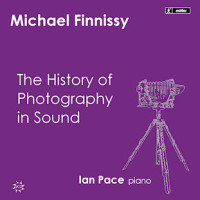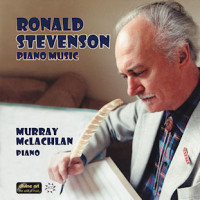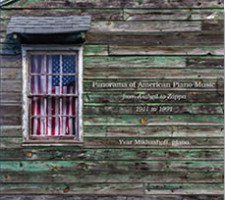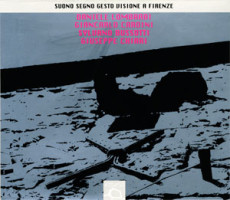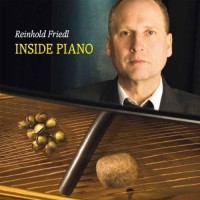Piano Factory 11.
|
Grant Chu Covell [December 2013.]
Michael FINNISSY: The History of Photography in Sound (1996-2000). Ian Pace (pno). Metier Records MSV 77501 (5 CDs) (http://www.divineartrecords.com/). Finnissy’s huge and nigh impenetrable opus suggests that music may comment only upon itself. Despite the Romantic age’s after-effects, music is just notes – intent and understanding are transient, perhaps irrelevant. A photograph purports to be a fixed moment in time, whereas Errol Morris’ recent essays explain that some photos are anything but factual. Performed music spans time. Upon reflection, one realizes how strange it is that we routinely accept something written days, months or years ago as timely. In other words, attend to Finnissy’s gigantic opus (49:11 + 59:32 + 74:18 + 67:42 + 76:18) with an open mind. To best get into the work start at the beginning. Le démon de l’analogie (28:29) and Le réveil de l’intraitable réalité (20:39) function as a prelude. Both titles derive from writings by Roland Barthes. Movements titled in English, French, Flemish, etc., are just one of the methods Finnissy employs to create an air of impenetrability. Le démon’s half-hour is unexpectedly plain. Le réveil winds up a bit more, just barely. The pace is slowed and the ears should be open. There are short, tightly controlled phrases or gestures to which Pace provides value. The meat of the work starts with North American Spirituals (23:41), a mammoth ramble through folk tunes and their impressions. There are moments when the music stops and prompts uncertain glances at the player. Complexity gears up in My parents’ generation thought War meant something (35:49). Entering the third disc with Alkan-Paganini (13:37), Seventeen Immortal Homosexual Poets (34:11) and Eadweard Muybridge-Edvard Munch (26:29), we are in the thick of complex, spluttering difficulty. This is where Pace’s 90-plus-page essay helps, if only to suggest the signs we should be looking for. I find it agreeable to consider the process much like watching someone flip through an album: It unites photography with the suggestion that Pace is merely perusing pages of an anthology. Some of Finnissy’s techniques (inversions, reversals) suggest browsing, especially as pages may be read backwards or upside down, with notes printed on the other side perhaps bleeding through. The biggest chapter, the 67:42 Kapitalistisch Realisme (met Sizilianische Männerakte en Bachsche Nachdichtungen), occupies the fourth disc’s entirety. Despite its unwieldy size, it is not difficult to navigate. From the outset we anticipate that Finnissy will appropriate Beethoven. The opening Fate gesture recalls the Fifth as well as Ives. Similarly, Wachtend op de volgende uitbarsting van repressie en censuur (17:01), halting at first, makes sense as a reflection, with its recurring fade-in, fade-out or crescendo-diminuendo from nothing, sounding a bit like someone fussing with the volume when in fact Pace amplifies gestures only to suddenly back away. Here too the analogy with album browsing seems appropriate. The sources and methods of Unsere Afrikareise (30:35) aren’t markedly different from the North American visit. The 11th and final movement, Etched bright with sunlight (28:40), opens with glittering activity. The movement and entire cycle end without even a modest flourish; nearly half an hour of complex activity suddenly breaks off. Pace’s longer 291-page illustrated book on the opus can be downloaded here. His insight and devotion serve to make the work as much his own as Finnissy’s.
Ronald STEVENSON: Var. comps. Murray McLachlan (pno). Divine Art DDA 21372 (3 CDs) (http://www.divineartrecords.com/). Of course there’s no way a Stevenson sampler wouldn’t be a richly textured sprawl. If you’re unfamiliar with Stevenson’s best known opus, Passacaglia on DSCH, you’re well advised to investigate it now. In these three discs (71:12 + 70:28 + 74:55) recorded across various sessions in 2009-10, McLachlan explores works ranging from virtuosic to vignettes a student could master. Like preceding composer-pianist virtuosos Busoni and Godowski, Stevenson freely reformulates music which has come before. McLachlan makes the nearly impossible Chopin elaborations sound easy. There are varied arrangements of Bach and Mozart, mightily elaborated paraphrases of John Bull, Purcell (including jazz variations), Chopin and Glazunov, latter-day popular song arrangements (Rachmaninoff, Coleridge-Taylor, Ivor Novello, Sigmund Romberg, et al.), a canonic treatment of the big themes from Strauss’ Die Fledermaus in turn reflecting Moritz Rosenthal’s Carnaval de Vienne, a two-hand arrangement of Busoni’s two-piano transcription of Mozart’s Fantasy for mechanical organ, K. 608, and so on. The second disc provides the largest offering, a concerto for solo piano without orchestra, Le festin d’Alkan (1997), which looks at Alkan in three ways: fantasies inspired by Alkan, transcriptions and elaborations of Alkan, and the music of others Alkan played. Two Ysaÿe solo violin sonatas (Nos. 1 and 2) have been transcribed for piano reflecting Stevenson’s absorption of Ysaÿe’s own Bach models. The sonatas, deep reimaginings in the Busoni vein, are far from their string originals. I find the Three Grounds, free transcriptions of Purcell, to be the most transfixing. Obviously, Purcell could never have written for the piano, yet Stevenson’s expansive melody placement and doubling works well.
“Panorama of American Piano Music from Antheil to Zappa, 1911-91.” Var. comps. Yvar Mikhashoff (pno). mode 262/65 (4 CDs) (http://www.moderecords.com/). An essential anthology of American piano works arranged chronologically extends the discography of the late Mikhashoff: 62 pieces from 48 composers including seven first recordings. The selections, reflecting Mikhashoff’s inclinations, beg the question of what qualifies as American music. The tour, opening with The Alcotts from Ives’ Concord Sonata, moves to works from folks we might expect: Copland, Cowell, Antheil, Gershwin, Ornstein, along with contributions that might surprise: Stravinsky, Bloch, Confrey, Bowles, Krenek, including other foreign-born composers who lived and worked in America. As the century progresses, the variety expands: Thomson, Ruggles, Gould, Davidovsky, et al., balanced with Feldman, Zappa, Glass, Rzewski, et al. I was happy to hear things I either had forgotten or never knew, including Griffes and Riegger’s American Impressionism in disc one, and later, the sampling of waltzes on disc three, an extension of “The Waltz Project” with which Mikhashoff had been involved. Despite a photo in the well-detailed booklet, there is no Carter here. Given what’s offered, we’re left with the impression that dissonance and complexity are largely absent from American music. While we all have our preferences, you’re likely to enjoy works on disc four of the late 1980s by Vigeland, Paulus, Ince, Schwantner, Leuning, Singleton, et al. Music by Cage and Antheil keep Mikhashoff at the keyboard absent interior preparations or touching the strings. Davidovsky’s Synchronisms No. 6 asks for tape; the selection from Crumb’s Makrokosmos requires amplification. Something by Cage appears on each disc. Other multiples include Antheil, Copland, Thomson, Glass and Harrison. This collection represents not just a swath of American music but Mikhashoff’s own ability at assembling marathons. In 1984 he programmed “Seventy Works in Seven Hours from Seventy Years, 1914-84,” recordings of which date from 1991 and 1992. Mikhashoff died of AIDS in 1993. These four discs (78:10 + 59:17 + 69:27 + 66:31) attest to his legacy. (Composers include: Antheil, Bernstein, Bloch, Bowles, Brant, Brown, Cage, Confrey, Constanten, Copland, Cowell, Crawford Seeger, Crumb, Curran, Davidovsky, Feldman, Foss, Gershwin, Glanville-Hicks, Glass, Grainger, Griffes, Harris, Harrison, Hovhaness, Ince, Ives, Gould, Moran, Nancarrow, Ornstein, Paulus, Powell, Riegger, Rudhyar, Ruggles, Rzewski, Schwantner, Sellars, Sessions, Singleton, Stravinsky, Thomson, Tower, Vigeland, Wolff, Young, and Zappa.) “Suono Segno Gesto Visione a Firenze.” Daniele LOMBARDI: Mitologie 2 (1991)1. Giancarlo CARDINI: Paesaggio marino al tramonto con barca e grande nuvola nera (1998)2; Bossa Nova and Vecchio Slow from Tre Danze (1997)3. Sylvano BUSSOTTI: Impromptu Cloarec – Claviers poétiques (1999)4. Giuseppe CHIARI: Gesti sul piano (1963-99)5. Daniele Lombardi1, Ciancarlo Cardini2,3, Sylvano Bussotti4, Giuseppe Chiari5 (pno). Atopos ATP 009 (1 CD) (http://www.atoposmusic.com/). Recorded live October 16, 1999, four composer-pianists celebrate the 20th year of the Florentine contemporary music association G.A.M.O. This quartet couldn’t be more different. Reflecting deep allegiance to contemporary music’s byways, Lombardi offers avant-garde musings in an abstract 18:45. Cardini’s exploration is more traditional and emotional, even Romantic. The Paesaggio marino evokes the sea a touch impressionistically. The work’s complete title: “A photograph by Enzo Della Monica set for piano and slide projection.” Cardini’s two dances, lovingly played, reflect popular music of a different age. Except for some polytonality, they might have come from a century earlier. With its rustic moments, ramble and ease, Bussotti’s nearly half-hour improvisation is surprisingly gentle. Here too Bussotti reacts musically to photographs, in this case snapshots taken by Jacques Cloarec. Chiari approaches the piano differently, rather like an explorer puzzled by the equipment’s mechanics, employing as much non-pianistic behavior as possible. We hear taps, for example, among inadvertent gestures. Documentation of other performances suggests the hands never touch the instrument in anything like a traditional manner.
“Inside Piano.” Reinhold FRIEDL: Var. comps. Reinhold Friedl (pno). Zeitkratzer ZKR 0013 (2 CDs) (http://www.zeitkratzer.de/). Friedl modified a Steinway D-274 with springs, rocks, metal and glass rods, bow hair and other devices, unleashing a universe from within the instrument. I am fairly certain that these sounds were captured live in a single take without post-processing. Complex sounds occur when resonant items are placed directly upon the strings vibrating in sympathy. Friedl creates avalanches and willowy textures. Sometimes the piano whines and growls. We have nine pieces across two discs (59:12 + 70:48), mostly large efforts. L’horizon des ballons (39:16) employs a metal rod. Some might wonder why Friedl removed the lid in order to get inside. In answer, innovation welcomes sound production from all angles, and Friedl is a master.
Antheil, Bernstein, Bloch, Bowles, Brant, Brown, Bussotti, Cage, Cardini, Chiari, Confrey, Constanten, Copland, Cowell, Crawford Seeger, Crumb, Curran, Davidovsky, Feldman, Finnissy, Foss, Friedl, Gershwin, Glanville-Hicks, Glass, Grainger, Griffes, Harris, Harrison, Hovhaness, Ince, Ives, Lombardi, M Gould, Moran, Nancarrow, Ornstein, Paulus, Powell, Riegger, Rudhyar, Ruggles, Rzewski, Schwantner, Sellars, Sessions, Singleton, Stevenson, Stravinsky, Thomson, Tower, Vigeland, Wolff, Young, Zappa
[More Grant Chu Covell, Piano Factory]
[More
Antheil, Bernstein, Bloch, Bowles, Brant, Brown, Bussotti, Cage, Cardini, Chiari, Confrey, Constanten, Copland, Cowell, Crawford Seeger, Crumb, Curran, Davidovsky, Feldman, Finnissy, Foss, Friedl, Gershwin, Glanville-Hicks, Glass, Grainger, Griffes, Harris, Harrison, Hovhaness, Ince, Ives, Lombardi, M Gould, Moran, Nancarrow, Ornstein, Paulus, Powell, Riegger, Rudhyar, Ruggles, Rzewski, Schwantner, Sellars, Sessions, Singleton, Stevenson, Stravinsky, Thomson, Tower, Vigeland, Wolff, Young, Zappa]
[Previous Article:
(Dis)Arrangements 2: Goldberg Fever]
[Next Article:
Jürgen Jürgens’ Trauer-Ode]
|
